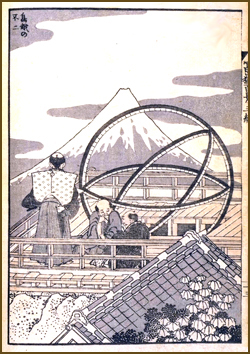Ginza and
Shin Sakanachoo 新肴町 Shin-Sakana Cho, Shinsakanacho district
"New Fish Village - Market"
Ginza Sanchome 銀座三丁目
Before Tokugawa Ieyasu came to Edo, there was a small fishing village at the Hibiya Inlet, Rogetsumura 老月村.
. 日比谷の入江 Hibiya no Irie inlet / 日比谷入江 .
Next to Hibiya mura were 桜田村 Sakurada mura, 老月村 Rogetsu mura and other villages.
As the town of Edo begun to grow and more and more people needed food, especially fresh fish, Rogetsu-Mura became a well-frequented fish market.
But in 1627, the Hibiya region was restructured and the land came under the control of the Bakufu government. Rogetsu-Mura was relocated near the Sotobori canal and renamed
"New Fish (market ) Village".

江戸魚市場めぐり(3)-新肴場 Shin Sakanaba -
「新肴場」、略して「新場」New Market と称しました
The major fish market at 魚河岸 Uogashi was then called 「古場」 Old Market
- reference source : blog.goo.ne.jp/kyrie999/e... -
There is also a bridge now, the
新場橋 Shinbabashi bridge.

Nearby is the
Momijidoori もみじ通り Edo Momiji-dori Avenue.
. Uogashi 日本橋魚河岸 fish market .
::::::::::::::::::::::::::::::::::::::::::::::::::::::::::::::::::::::::::::::::::::::::::::::::::::::::::::::::::::::::::::::::::::::::::::::::::::::::::::::::::::::::::::::::::::
Shin Sakanachoo 新肴町 Shin-Sakana Cho, Shinsakanacho district
"New Fish Village - Market"
Ginza Sanchome 銀座三丁目
Before Tokugawa Ieyasu came to Edo, there was a small fishing village at the Hibiya Inlet, Rogetsumura 老月村.
. 日比谷の入江 Hibiya no Irie inlet / 日比谷入江 .
Next to Hibiya mura were 桜田村 Sakurada mura, 老月村 Rogetsu mura and other villages.
As the town of Edo begun to grow and more and more people needed food, especially fresh fish, Rogetsu-Mura became a well-frequented fish market.
But in 1627, the Hibiya region was restructured and the land came under the control of the Bakufu government. Rogetsu-Mura was relocated near the Sotobori canal and renamed
"New Fish (market ) Village".

江戸魚市場めぐり(3)-新肴場 Shin Sakanaba -
「新肴場」、略して「新場」New Market と称しました
The major fish market at 魚河岸 Uogashi was then called 「古場」 Old Market
- reference source : blog.goo.ne.jp/kyrie999/e... -
There is also a bridge now, the
新場橋 Shinbabashi bridge.

Nearby is the
Momijidoori もみじ通り Edo Momiji-dori Avenue.
. Uogashi 日本橋魚河岸 fish market .
::::::::::::::::::::::::::::::::::::::::::::::::::::::::::::::::::::::::::::::::::::::::::::::::::::::::::::::::::::::::::::::::::::::::::::::::::::::::::::::::::::::::::::::::::::










































